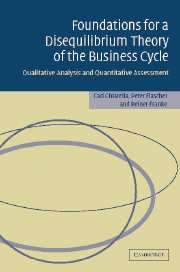 Foundations for a Disequilibrium Theory of the Business Cycle
Foundations for a Disequilibrium Theory of the Business Cycle Book contents
- Frontmatter
- Contents
- List of figures
- List of tables
- Foreword by J. Barkley Rosser, Jr.
- Preface
- Notation
- 1 Competing approaches to Keynesian macrodynamics
- Part I Textbook Approaches
- Part II Analytical Framework: Theory and Evidence
- Part III Monetary Policy
- 8 The Taylor rule in small macromodels
- 9 Incorporating the Taylor rule into KMG
- References
- Index
9 - Incorporating the Taylor rule into KMG
Published online by Cambridge University Press: 22 September 2009
- Frontmatter
- Contents
- List of figures
- List of tables
- Foreword by J. Barkley Rosser, Jr.
- Preface
- Notation
- 1 Competing approaches to Keynesian macrodynamics
- Part I Textbook Approaches
- Part II Analytical Framework: Theory and Evidence
- Part III Monetary Policy
- 8 The Taylor rule in small macromodels
- 9 Incorporating the Taylor rule into KMG
- References
- Index
Summary
Introduction
After studying the Taylor rule in the setting of small macrodynamic models in chapter 8, we now take the obvious step and integrate these interest rate adjustments into the KMG model. It has already been made clear that the Taylor rule is here substituted for the LM part of the model, while all the other components of KMG are maintained. We can emphasize this conception by calling the resulting model a Keynes–Metzler–Goodwin–Taylor model. Referring to the full label is somewhat cumbersome, but the simple acronym KMGT is more fluid. Since it also has the advantage of squarely pointing to the distinction between employing, or not employing, the Taylor rule in our KMG framework, we hereby formally introduce the term KMGT. It will be used in particular when we compare the properties of this new model to those of the original KMG model.
In setting up the reduced form of the KMGT model, it turns out that the KMG model's equation for the motion of real balances m = M/pK is replaced by a differential equation for the rate of interest i. The equations governing the other five dynamic variables are preserved, except that now the interest rate enters directly as a state variable in the investment function instead of the LM schedule i = iLM(m, ye, n). Already this moderate change, however, makes a serious difference, in that the attractive properties that have been found in the KMG model do not generally carry over to KMGT.
- Type
- Chapter
- Information
- Foundations for a Disequilibrium Theory of the Business CycleQualitative Analysis and Quantitative Assessment, pp. 427 - 504Publisher: Cambridge University PressPrint publication year: 2005


